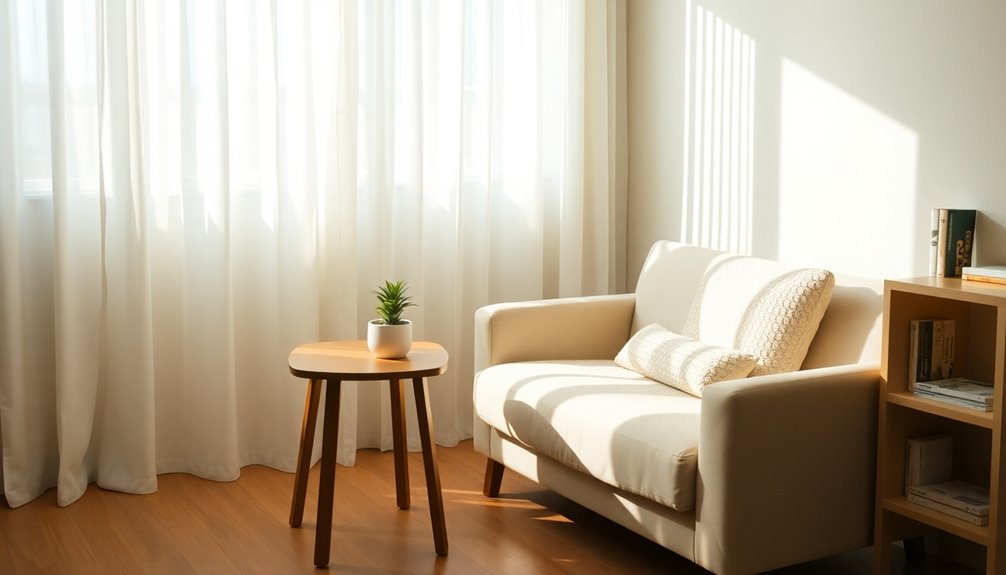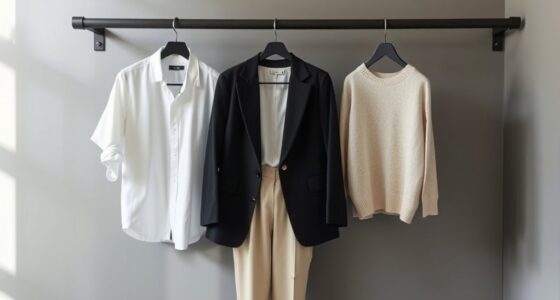Minimalist living on a budget is all about prioritizing essentials and cutting unnecessary spending. Start by evaluating your space and decluttering regularly. Use strategies like the "one in, one out" rule and seasonal reviews to keep things manageable. Focus on mindful purchasing by investing in quality items that last. Cultivating gratitude for what you have can shift your mindset. If you want practical tips to create a clutter-free environment, there's more to discover on this journey.
Key Takeaways
- Start with small decluttering sessions, focusing on one area at a time to avoid overwhelm and create a more organized space.
- Implement the "one in, one out" rule to maintain balance and prevent clutter from accumulating with new purchases.
- Regularly assess belongings, using seasonal reviews to identify and remove items that are no longer needed or used.
- Emphasize quality over quantity by investing in durable, timeless items that serve multiple purposes and reduce future spending.
- Foster mindful purchasing habits by creating shopping lists and setting monthly spending limits to curb impulse buys and unnecessary clutter.
Understanding Minimalism and Its Financial Benefits
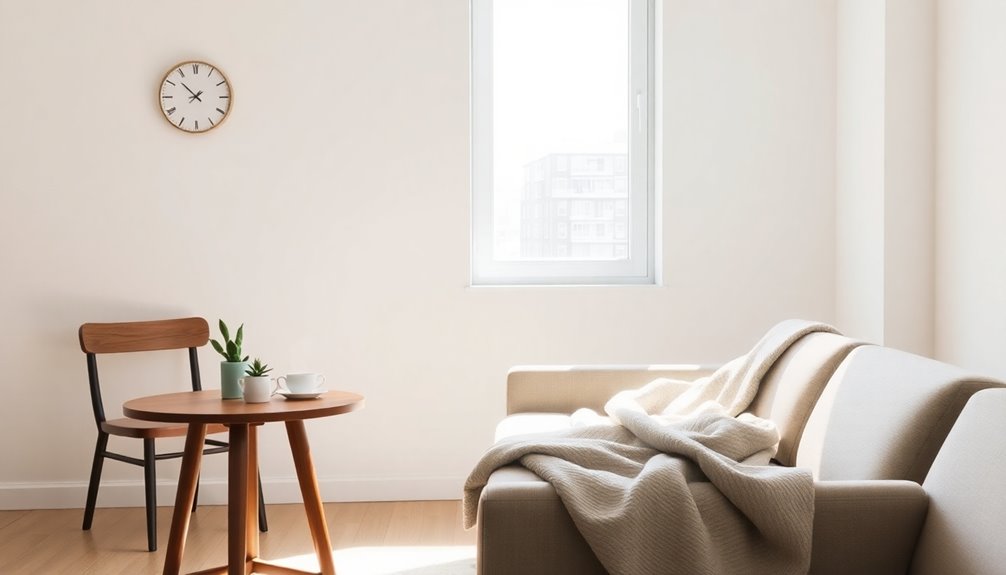
Although many people view minimalism as merely a lifestyle choice, it can also serve as a powerful tool for financial freedom. By embracing minimalist living, you'll learn to differentiate between your essential needs and wants, leading to reduced spending and less debt.
This shift allows you to save money by investing in quality items that last longer, rather than constantly replacing cheap purchases. Decluttering and selling unused items not only streamlines your space but also boosts your budget.
Additionally, practicing minimalism helps you avoid lifestyle inflation, enabling you to save or invest extra income. Regularly cutting unnecessary expenses, like digital subscriptions or dining out, aligns perfectly with the minimalist philosophy of living with less while improving your financial situation. Moreover, adopting a minimalist approach can enhance your understanding of net worth tracking, providing a clearer picture of your financial health.
Evaluating Your Space and Priorities
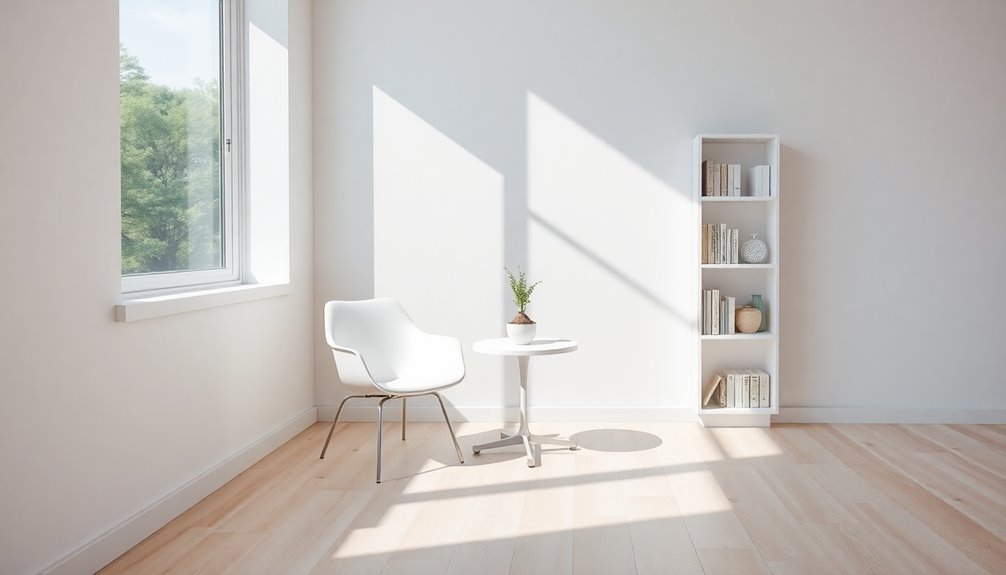
How can you create a living space that truly reflects your values and priorities?
Start by evaluating your space and belongings. Focus on decluttering your home to spend less time managing clutter and more time enjoying what matters.
Here are some practical steps:
- Observe your home for duplicates and clutter zones.
- Regularly remove items you don't use or see often.
- Implement a seasonal review of your closet and belongings.
- Use the one-in, one-out rule to maintain balance.
Additionally, consider incorporating essential elements for a farmhouse dining room to create a warm and inviting atmosphere that aligns with your minimalist lifestyle.
Effective Decluttering Strategies
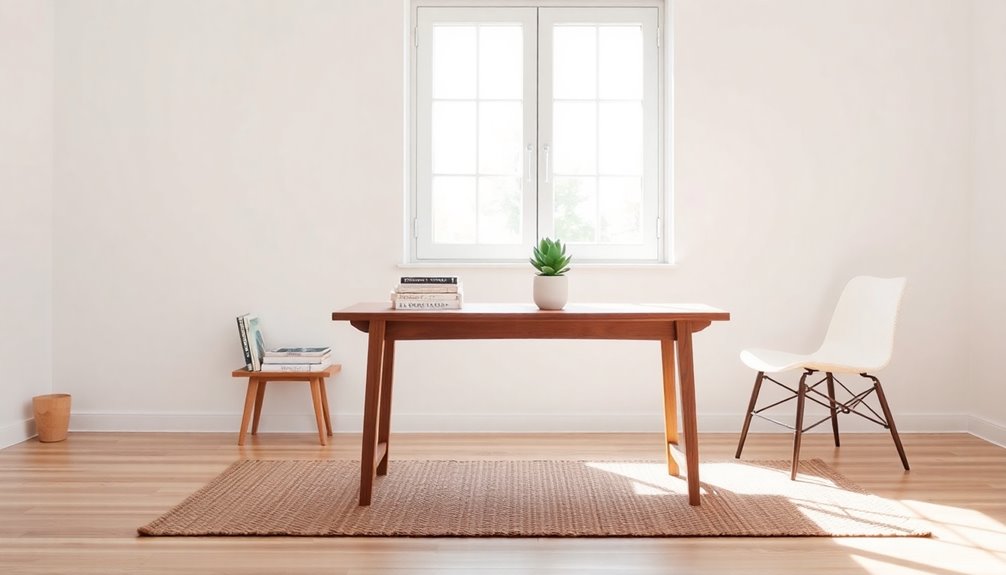
When it comes to decluttering your space, starting small can make a significant difference. Focus on one area, like a drawer or shelf, to avoid feeling overwhelmed and to see quick results.
Implement the "one in, one out" rule: every time you bring something new home, remove an item. This helps maintain a clutter-free environment and encourages thoughtful decisions.
You can also try the KonMari method, organizing by category to spot duplicates and items that no longer serve you.
Schedule regular evaluations, like a seasonal closet review, to identify what you truly need.
Finally, set up a donation bag routine, filling it monthly with unwanted items to make decluttering manageable and reduce stress. Additionally, consider how mattress toppers can be a practical addition to your space, enhancing comfort while minimizing clutter.
Mindful Purchasing Habits
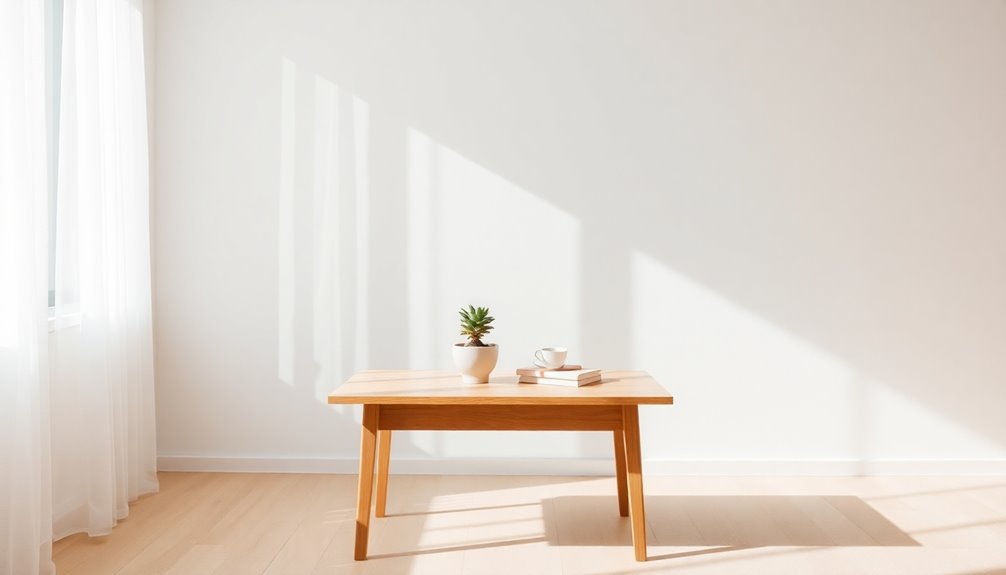
When you consider a purchase, ask yourself if it truly fits your minimalist goals. Think about whether the item will enhance your life or just add to the clutter. Additionally, consider the cost of building a tiny house as a reminder that investing in meaningful items can lead to a more fulfilling and minimalistic lifestyle.
Intentional Shopping Decisions
- Assess Value: Before buying, ask if this item adds value or chaos to your life.
- One in, One out: Adopt the "one in, one out" mindset—remove an item for every new acquisition.
- Create a List: Write a shopping list to avoid impulse purchases and stick to your budget.
- Set Limits: Establish monthly spending limits to hold yourself accountable for quality over quantity.
Additionally, practicing mindfulness techniques can help enhance your awareness of purchasing habits and reduce stress associated with clutter.
Evaluating Purchase Necessity
How can you determine if a purchase is truly necessary? Start by evaluating purchase necessity through practical use versus clutter contribution. Reflect on why you want the item—are you swayed by trends or discounts? Implementing the one-in, one-out rule can help maintain balance; for every new acquisition, let go of an existing item to prevent clutter.
Here's a quick guide to assess your purchase:
| Question | Yes/No |
|---|---|
| Will it serve a practical purpose? | Yes/No |
| Am I influenced by trends? | Yes/No |
| Can I live without it? | Yes/No |
| Does it fit my budget? | Yes/No |
| Will I spend time evaluating it later? | Yes/No |
In evaluating your purchases, consider how they contribute to your overall well-being, much like how essential oils can enhance respiratory health and promote a clearer mind.
Emphasizing Quality Over Quantity
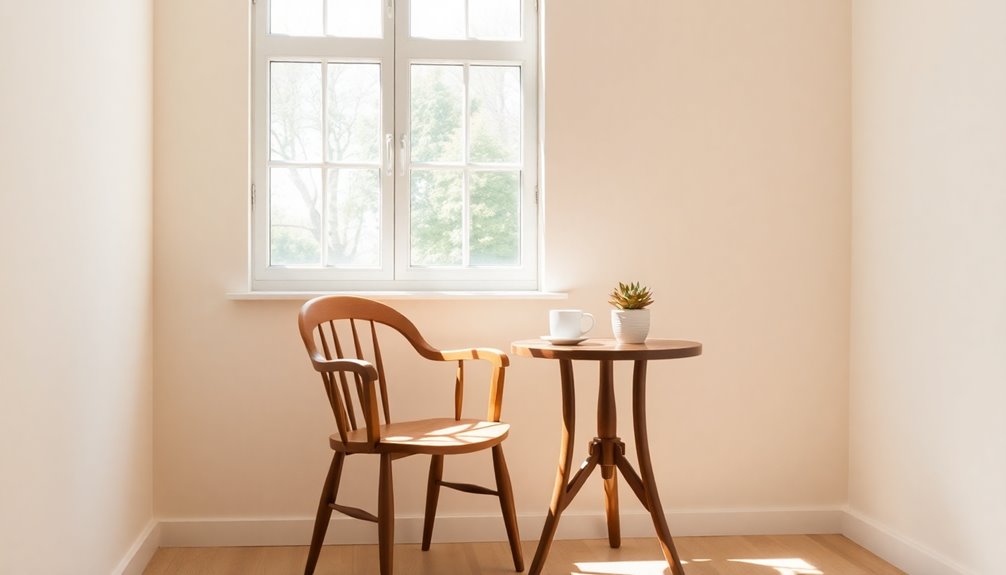
When you focus on quality over quantity, you'll find that investing in durable products pays off in the long run. Choosing timeless styles not only elevates your space but also helps you avoid the cycle of constant replacement. Additionally, embracing sustainable practices in your purchasing decisions can lead to a more eco-friendly lifestyle.
Durable Product Investment
Investing in durable products can transform your approach to minimalist living and budgeting.
By focusing on quality items, you can reduce clutter and save money over time. Here are some key benefits of durable product investment:
- Long-lasting: Quality items last up to three times longer than cheaper alternatives.
- Cost-effective: Spending on fewer, high-quality products reduces the need for frequent replacements.
- Satisfaction: Investing in well-made goods leads to greater satisfaction and less desire for unnecessary purchases.
- Maintenance: Fewer items mean easier upkeep and a more streamlined home.
Additionally, embracing mindful consumption encourages a more sustainable lifestyle that aligns with your minimalist goals.
Timeless Style Choices
Focusing on durable products naturally leads to making timeless style choices that prioritize quality over quantity. Investing in a capsule wardrobe filled with versatile, quality items guarantees you have stylish outfits without clutter.
By choosing classic, timeless styles over fleeting trends, you create a sustainable wardrobe that requires fewer replacements. This approach not only enhances your minimalist aesthetic but also saves you money in the long run.
Opt for multi-purpose accessories to streamline your choices, allowing you to maintain a cohesive look. Emphasizing quality over quantity fosters mindful purchasing habits, aligning with minimalist values. Additionally, incorporating unique pieces into your decor can enhance the overall aesthetic and reflect your personal style.
Ultimately, this strategy results in a more organized and satisfying wardrobe, reflecting your commitment to lasting style and intentional living.
Mindful Spending Practices
While embracing a minimalist lifestyle, it's essential to adopt mindful spending practices that emphasize quality over quantity.
By focusing on living with less, you can create a more meaningful environment.
Consider these practices to guide your purchases:
- Invest in durable items that last longer, reducing replacements.
- Prioritize timeless pieces that enhance your life and style.
- Embrace a one-in, one-out mentality to keep clutter at bay.
- Evaluate each purchase critically, ensuring it serves a purpose.
Additionally, consider investing in affordable vacuum cleaners that provide high performance without cluttering your space with unnecessary devices.
Cultivating a Mindset of Gratitude
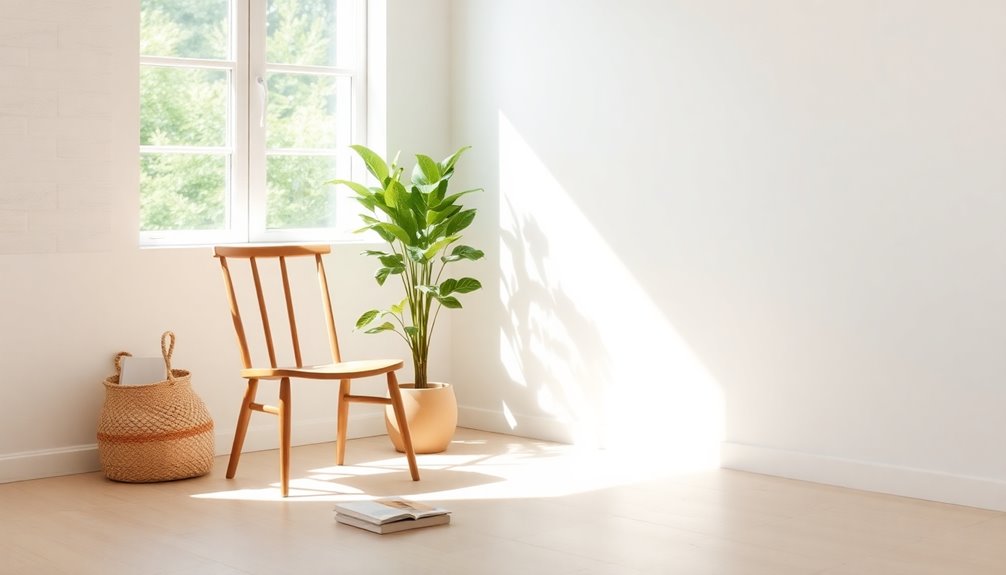
How often do you take a moment to appreciate what you already have? Cultivating a mindset of gratitude helps you embrace contentment with your current possessions. By acknowledging the beauty and utility of what you own, you shift your focus from scarcity to abundance. This practice not only reduces stress but also enhances emotional well-being and strengthens relationships.
| Gratitude Practice | Benefits | Suggested Items |
|---|---|---|
| Keep a Gratitude Journal | Increased mental clarity | Notebook, pen |
| Daily Appreciation | Enhanced emotional well-being | Daily reminder |
| Share Gratitude | Stronger relationships | Conversations, notes |
| Reflect on Possessions | Reinforced minimalist values | Personal items |
Embracing gratitude leads to a more fulfilling minimalist lifestyle.
Regular Purging for a Clutter-Free Home
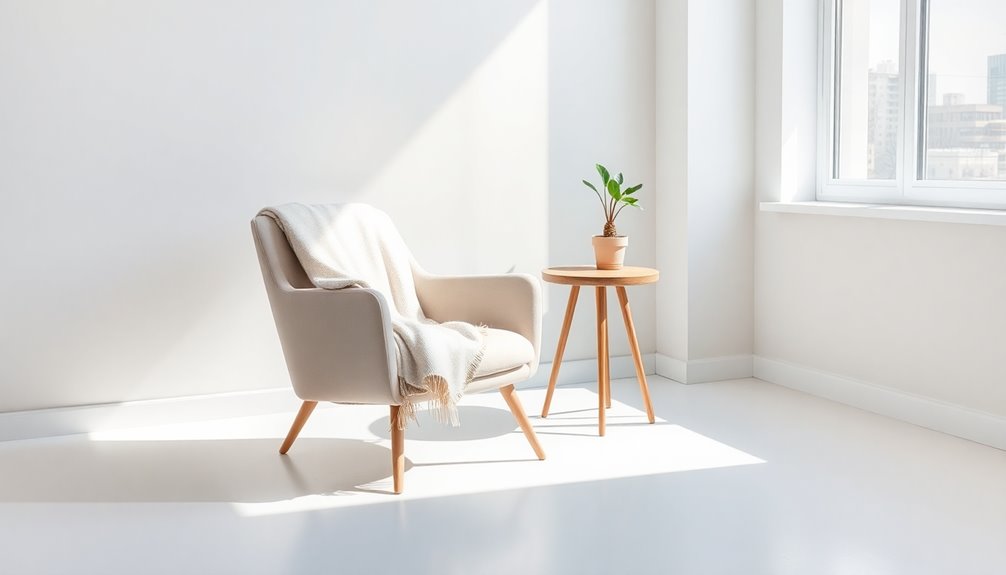
Regular purging is essential for maintaining a clutter-free home, as it allows you to create a space that reflects your minimalist values.
To keep your environment organized, consider these strategies:
- Establish a routine for regular purging, like a monthly review of belongings.
- Implement the one-in, one-out rule; for every new item you bring in, let go of an existing one.
- Use seasonal decluttering sessions to assess and part with items that no longer serve you.
- Set up a donation box in a convenient spot for spontaneous purging of unwanted items.
Managing Sentimental Items Wisely
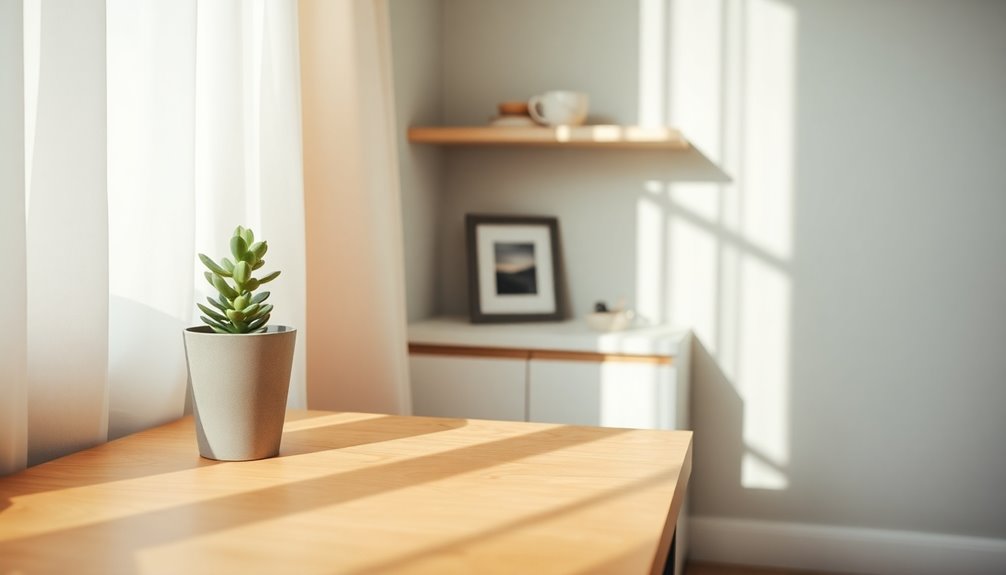
Managing sentimental items wisely can be a challenge, especially when they hold special memories. To keep your collection manageable, be selective and only hold onto items that truly bring you joy or have deep meaning.
If you find you need an item but don't want to keep it, consider taking photographs to document it before letting it go. This way, you preserve the memories without the clutter.
You can also pass cherished items to family or friends who might appreciate them more. Creating a memory box helps limit what you keep, ensuring it includes only the most significant pieces.
Regularly assess your collection to see if those items still hold emotional value, adjusting as necessary to maintain your minimalist lifestyle.
Practicing Digital Minimalism

Digital minimalism can transform your online experience, making it more intentional and less overwhelming.
By managing your digital possessions, you can create a calmer digital space. Here are some practical steps to get started:
- Declutter your devices by removing unused apps, emails, and files.
- Set boundaries for screen time and social media usage to stay focused on what truly matters.
- Utilize cloud storage to keep essential documents accessible while minimizing physical clutter.
- Regularly review and cancel unnecessary digital subscriptions to avoid accumulating small fees.
Frequently Asked Questions
What Is the 30/30 Rule for Minimalists?
The 30/30 Rule for minimalists is a simple guideline that helps you decide what to keep and what to let go.
If an item takes less than 30 seconds to replace and costs under $30, it's probably not worth holding onto if it adds clutter to your life.
This rule encourages you to evaluate your possessions critically, making it easier to declutter and focus on what truly matters to you.
What Is the 90-90 Rule for Minimalism?
The 90-90 rule for minimalism helps you assess your belongings effectively.
If you haven't used an item in the last 90 days and don't expect to use it in the next 90 days, it's probably time to let it go.
This approach encourages you to evaluate your possessions based on actual use rather than emotional ties, leading to a clearer, more organized space that enhances your mental clarity and reduces stress.
What Is the 20/20/20 Rule for Minimalists?
When you're facing the clutter conundrum, consider the clever 20/20/20 rule.
If an item costs less than $20 and takes under 20 minutes to replace, you can confidently discard it. This simple strategy helps you shed stress and simplify your space.
How Do You Declutter Minimalist Living?
To declutter effectively, start with small spaces like a bathroom drawer or kitchen shelf. This'll give you quick wins and boost your motivation.
Adopt the one-in, one-out rule to maintain balance in your belongings. Regularly evaluate your items, getting rid of duplicates or things you haven't used in a year.
Organize by category using the KonMari method, and set a seasonal review to keep your living space streamlined and clutter-free.
Conclusion
Embracing minimalist living doesn't mean sacrificing joy; it's about creating space for what truly matters. By letting go of excess and focusing on quality, you'll find freedom in simplicity. Remember, it's not just about decluttering your home, but also your mind. As you practice gratitude and mindful purchasing, you'll discover that less really can be more. So, take a deep breath, enjoy the lighter load, and relish the beauty of a more intentional life.
